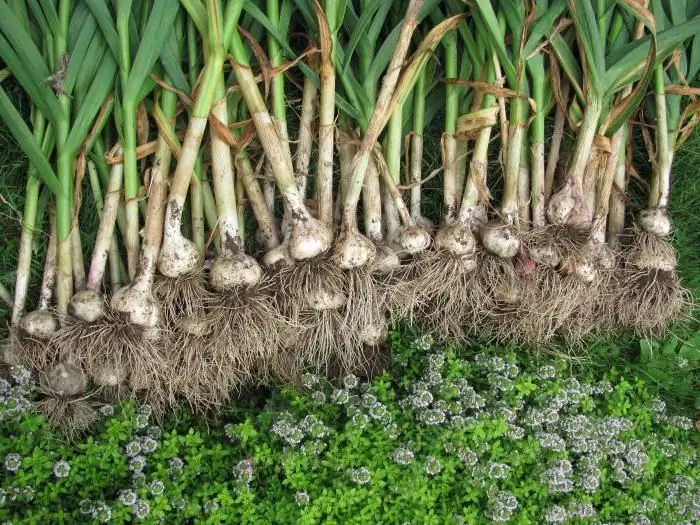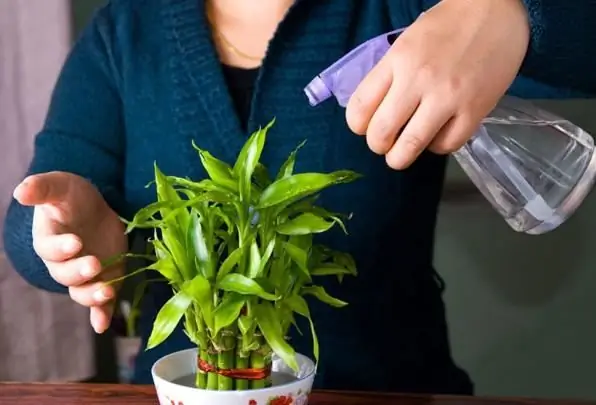2025 Author: Howard Calhoun | [email protected]. Last modified: 2025-01-24 13:10:43
Wild ramson is the most valuable wild plant, used in cooking and folk medicine since ancient times. According to archaeologists, wild garlic was eaten more than 5,000 years ago. Its unique properties were valued in ancient Rome and in the medieval states of Europe.
Today wild garlic is still loved and revered in the widest territories, although in different regions this word means plants of various species. In Europe, the Caucasus and Asia Minor wild garlic is a bear's onion. This is how its specific name is translated from Latin. And in the Urals and Altai, in Siberia and Kamchatka, in Mongolia, Japan, China and even in North America, wild garlic is called a victorious onion, the view is much more common. The habitat of these two onions converges in the Caucasus, where they both meet.

Outwardly, these plants are very similar. Perennial, similar in appearance to lily of the valley, with a spicy aroma and taste reminiscent of garlic and onions at the same time, they are the first to appear in the forests from under the snow. Both bears and other animals, and after them people, are trying to restore their strength after a long winter with this early greenery. itno wonder, because wild garlic is the richest source of essential oils, vitamins and valuable nutrients. For example, it contains 10 times more vitamin C than a lemon!
In recent years, more and more people are thinking about how to grow wild garlic on their own plot. On the one hand, the bear's onion has become endangered due to the massive collection. On the other hand, there are fewer and fewer people who want to collect wild wild garlic due to the activity of ticks. So it turns out to be more profitable and safer to grow a useful plant on your own.
How to grow wild garlic in your garden
For planting wild garlic, choose a flat area in the shade of trees, where melt water does not stagnate. Ramson, of course, loves the sun. But she manages to get enough light before the leaves appear on the trees. And in the summer, when the dormant period begins for the bulbs, the wild garlic will be reliably hidden from drying out and overheating. For trees in the garden, such a neighborhood is also useful: the high phytoncidal activity of wild garlic repels pests, its growth prevents the appearance of weeds.
The soil of the bear's onion needs loose, cultivated 30-40 cm deep, enriched with organic matter. These are conditions that are as close as possible to the natural environment of its growth. Before planting, it is advisable to add compost or rotted manure at the rate of a bucket/1m2, ammonium nitrate (15 g), superphosphate (30-40 g), potassium s alt (15-20 g).

How to grow wild garlic vegetatively
Planting bulbs is the most preferredmethod of growing wild garlic. The bulb is planted so that the reticulum surrounding it is visible on the surface. A distance of 35 - 40 cm is maintained between the holes in order to avoid thickening of the planting for 4 - 5 years. But 1-2 bulbs are planted in each hole to guarantee survival. Wild garlic is transplanted from mid-July to mid-September. At this time, the plant is already at rest and has time to get stronger in a new place before the onset of cold weather.
How to grow wild garlic from seeds
Already in early July, wild garlic seeds gradually ripen and fall off, so it is important to collect them in a timely manner. It is necessary to sow immediately, germination is lost very quickly.
Sown the seeds to a depth of 2 - 3 cm in well loosened and lightly mulched moist soil. Shoots that appear in spring are very thin and tender, they are easy to destroy when weeding or loosening. Therefore, it is better to use a box with earth for sowing. In autumn, it can be dug on the site, covered with snow. Only in the third year will wild garlic from seeds grow to a normal size.
Caring for wild garlic
The plant is unpretentious. With minimal care, a few years after planting, you will be rewarded with a meadow of wild garlic, a photo of which will be difficult to distinguish from wild thickets.

In early spring, when the first shoots of wild garlic just appear, the area with plantings must be carefully cleared of last year's leaves. Mid-April is the time to apply nitrogen fertilizer in solution (15-20 g of urea per bucket of water). After flowering (May - June)top dressing is carried out with complete mineral fertilizer (wood ash at the rate of 30 g per bucket of water).
The soil is kept moist throughout the growing season. Already in mid-July, when the leaves begin to turn yellow, watering must be stopped.
Each year, the bulbs rise from the ground by 0.5 cm and take horizontal roots. Therefore, starting from the second year of growth, it is useful to sprinkle them with fallen leaves. A thin layer of dead leaves will recreate the natural life of the plant and reduce the amount of fertilizer applied.
In winter, with good snow cover, additional shelter is not required. If there is little snow, you can cover the plants with spruce branches, straw or fallen leaves.
As you can see, growing wild garlic is not difficult at all. All efforts to care for plantings pay off many times over with its invaluable benefits.
Recommended:
Garlic cultivation as a business: a business plan, methods and features of technology. Growing garlic on an industrial scale

The owners of suburban areas, by definition, have a few more opportunities to organize a home business. You can, for example, not only engage in gardening or growing fruits and vegetables, but also have pets. Although, of course, many summer residents and aspiring entrepreneurs prefer crop production to caring for animals. This is not only a less labor-intensive undertaking - growing vegetables and fruits does not require such large financial investments and pays off faster
Fertilizer "Ideal" - a universal tool for the development and growth of garden, garden and indoor plants

The "Ideal" fertilizer contains all the nutrients, macro- and microelements necessary for the formation and growth of the root system, leaves and fruits of plants
Crop rotation in the garden. What then can be planted in the garden

Growing vegetables and herbs in your garden for many today is both a useful and a favorite pastime. Of course, it is very important to get a good harvest from your site. The best result is achieved when the crop rotation in the garden is properly adjusted
Tips on how to grow onions per head in the garden

Onions, as they used to say in the old days, from seven ailments. We do not forget about this either. Official medicine prescribes pharmaceutical onion preparations - "Allilchep", "Allylglycer" and others. Onion is widely used in traditional medicine
Garden-garden: how to feed strawberries

Strawberry is one of the most favorite crops of our summer residents. Her berries are, of course, tasty and extremely he althy. However, in order to get a good harvest, of course, you need to know some rules of agricultural technology. For example, how to feed strawberries

